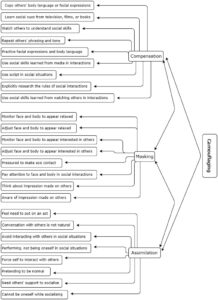For many autistic individuals, navigating social expectations may mean adopting a practice known as camouflaging, sometimes referred to as masking. While there is not necessarily an agreed-upon term, we will highlight the distinction between camouflaging and masking. In a broad sense, camouflaging refers to coping skills and strategies one uses to disguise, hide or suppress certain traits to be more positively perceived.
Camouflaging can occur consciously or subconsciously, and to a degree, everyone camouflages throughout their life to ‘fit in’. Most social manners and niceties can be classified as camouflaging; however, it goes deeper for autistic individuals. Autistic individuals camouflage often to appear neurotypical.
Embrace Autism Inc. explains, “We learn social skills to improve social interaction, we adhere to social conventions that may not make complete sense to us, and we adjust our behavior as the situation demands.” Nevertheless, camouflaging is often a lot less surface-level for autistic individuals. Camouflaging one’s autistic traits requires a great deal of energy and a lot of thought. While camouflaging can help with social acceptance, it often comes at a cost and can lead to anxiety, exhaustion and a loss of self-identity for many autistic individuals.
Autistic individuals may camouflage their traits for a variety of reasons, including:
- To get a job offer or work promotion
- To make friends
- To demonstrate intelligence, success, trustworthiness, etc.
- To be taken seriously
- To bond or fit in with others
Getting an autism diagnosis
Autism spectrum disorder (ASD) is uniquely characterized by persistent deficits in social communication and social interaction across multiple contexts according to the DSM-5. The diagnostic process for autism involves a series of behavioral assessments, developmental screenings and communication evaluations. Due to the inherent nature of camouflaging, some individuals may experience delay with getting their official autism diagnosis.
Presently, autism is identified at nearly four times the rate in boys compared to girls. Newer research suggests that camouflaging is highly prevalent in girls and that girls may be more aware of how they present in social situations. Such proposed self-awareness leads to a higher likelihood of camouflaging and being under or misdiagnosed.
Types of camouflaging
A study conducted by Hull et al. (2018) categorized camouflaging by three main factors: masking, compensating and assimilating.
- Masking: Strategies used to present a non-autistic or less autistic persona to others.
- Examples may include suppressing stimming/repetitive behaviors, ignoring personal discomfort to triggering stimuli or choosing not to share interests that may be considered socially unusual.
- Compensating: Strategies used to compensate for social and communication difficulties.
- Examples may include being overly polite/agreeable or scripting conversations.
- Assimilating: Strategies used to fit into uncomfortable social situations.
- Examples may include imitating or mimicking facial expressions, gestures, and speech patterns.
Figure 1 from: Hull et al. (2018). Development and Validating of the Camouflaging Autistic Traits Questionnaire (CAT-Q).
Combatting the negative effects of camouflaging
Consistently camouflaging over time can contribute to mental health struggles including:
- Loss of identity
- Anxiety
- Depression
- Stress
- Exhaustion
- Loss of function
- Struggles with independent living
- Lack of empathy from neurotypical people
Camouflaging can lead to autistic burnout if an individual does not have adequate support. Some researchers suggest that accepting autism as part of one’s identity can boost self-esteem and reduce feelings of depression, stress and anxiety. Not only does personal acceptance help to combat the negative effects of camouflaging, but acceptance from friends and family members does as well. If a loved one of yours has autism, you must make sure they know there is nothing wrong with them and they shouldn’t feel they have to camouflage around you.
As an autistic person, you can implement solutions that allow camouflaging to take on a lesser negative effect. Substituting stimming behaviors with alternatives can be suitable for more public situations where you may otherwise camouflage. You can also ask for reasonable accommodations in the workplace such as a private desk or flexible schedule.
Reputable ABA therapy can help autistic individuals learn the social skills needed for positive interactions, without promoting camouflaging. ABA therapy does not aim to teach autistic individuals that different ways of being are wrong or what they may need is wrong. Rather, ABA therapy can help autistic individuals learn to communicate what they may need in ways they are less likely to be misunderstood.
Maxim Healthcare Services uses an empathy-based approach and evidence-based practices tailored to the needs of everyone. Our clinical supervisors work directly with each patient to develop meaningful, individualized goals, and support and celebrate their individuality.
Developmental Disabilities Awareness Month
March is Developmental Disabilities Awareness Month, an annual campaign that highlights how people with and without disabilities come together to form strong communities. The National Association of Councils on Developmental Disabilities (NACDD) has recognized Developmental Disabilities Month since 1987.




